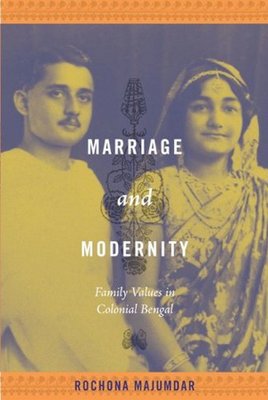Marriage and Modernity: Family Values in Colonial Bengal

Rochona Majumdar's firmest statement in Marriage and Modernity: Family Values in Colonial Bengal is that the Western conception of arranged marriage is dated. The portrayal of arranged marriage as immoral suited the Western sense of superiority over the “Hindoos,” despite the fact that Western courtship was riddled with its own problems. Arranged marriage is obviously the creation of a certain cultural condition and sought to fulfill certain perceived needs. After cautioning her audience against a lens of liberal progressivism, Majumdar narrates the evolution of arranged marriage into modernity.
As culture changed and the expectations and ideals of family changed with it, urban society and the escalation of technology impacted arranged marriage in no small measure. Majumdar's discussion of the matrix of influences that impacted arranged marriage is a fascinating study in the modernization of customs.
Majumdar begins by describing how the ghaktas—traditional matchmakers—became seen as antiquated and irreputable and were replaced by early “personals” in print. She continues on to discuss how this format reflected other cultural trends, such as the increasing fluidity of the caste system. Of special importance is the impact of the dowry on the economy. A woman's appearance, accomplishments, and social standing all factored into the negotiation of price, which could be enormous. At the peak of cultural anxiety over this issue, a young girl, Snehalata Mukhopadhyay, committed suicide rather than see her family ruined. In her discussion of the dowry and the maelstrom of controversy over Mukhopadhyay 's death, Majumdar proves especially interesting; the suicide became a symbol for the direness of a woman's circumstances, and was used as a rhetorical device for feminists and other reformists generally.
The marriage flux became a matter of crucial moral and legislative importance. As arranged marriage was modernized, certain segments of the population began to rebuke marriage as “degraded” from its original, “pure” incarnation. The ideals of marriage, it was claimed, were lost amidst all the economic concerns. As dowries and wedding costs became extravagant, the rituals performed in the ceremony itself became a matter of critique. Rituals were a forum to discuss the proper role of women within marriage and society and to discuss matters such as women's modesty, dress, and duties to her husband.
Throughout this period, too, was the influence of the English conception of individuality and love. Many tried to find means to incorporate this into a traditional picture of married life—literally so in the form of the portrait, an invention which, Majumbar claims, shows the couple's new centrality to family life.
Ritual has its legislative consequences as well, and Majumbar also discusses two crucial moments in the history of Bengali marriage: the first civil marriage act in India, which ignited a debate on wedding ritual and recognition by law, and the Hindu Code Bill, which addressed issues of property and who set the tone for India's cultural development into postmodernity.
Moral commentary is beyond Majumdar's scope, as is a consideration of the role of ethics in anthropology in general—though she touches on it briefly in the conclusion. However, good anthropology tends to invite reflection on one's own cultural moment, and—if we believe the hype—we are in a similar moment as that of colonial Bengal; we are also concerned with the “purity” of marriage, its impact upon the economy, its uses of technology like the Internet, and traditional ritual's relationship with legal recognition. The debates on marriage in colonial Bengal are, in many ways, our own.